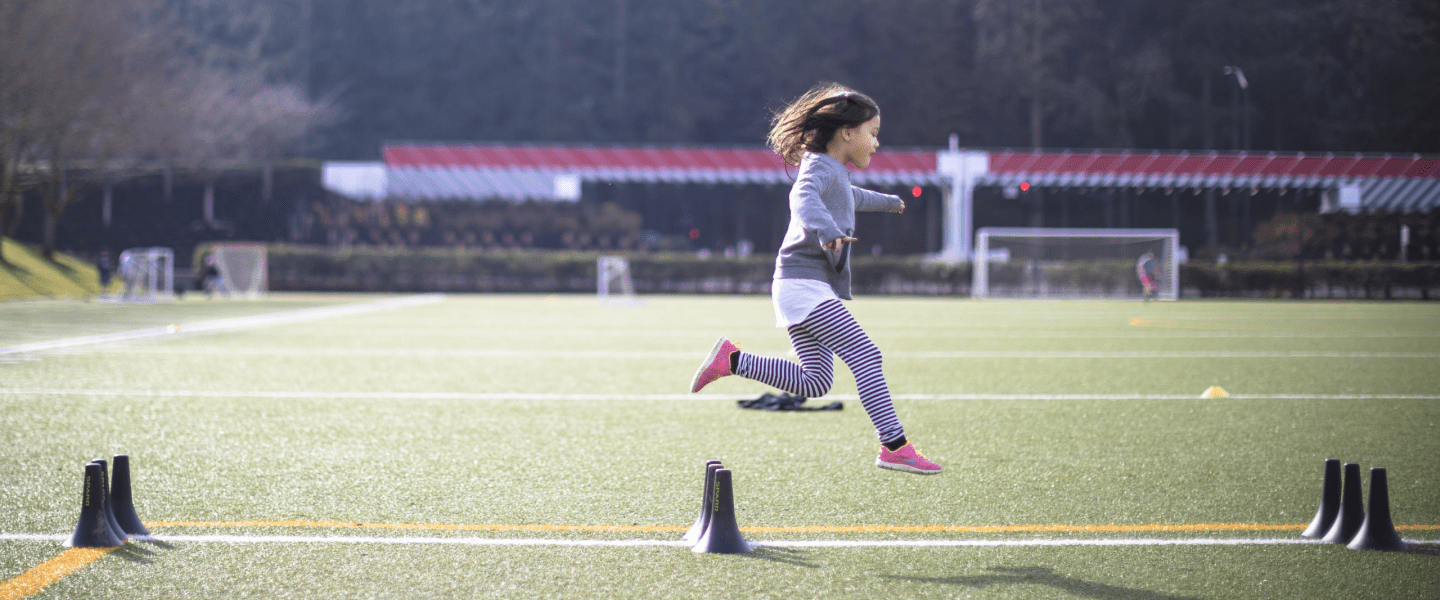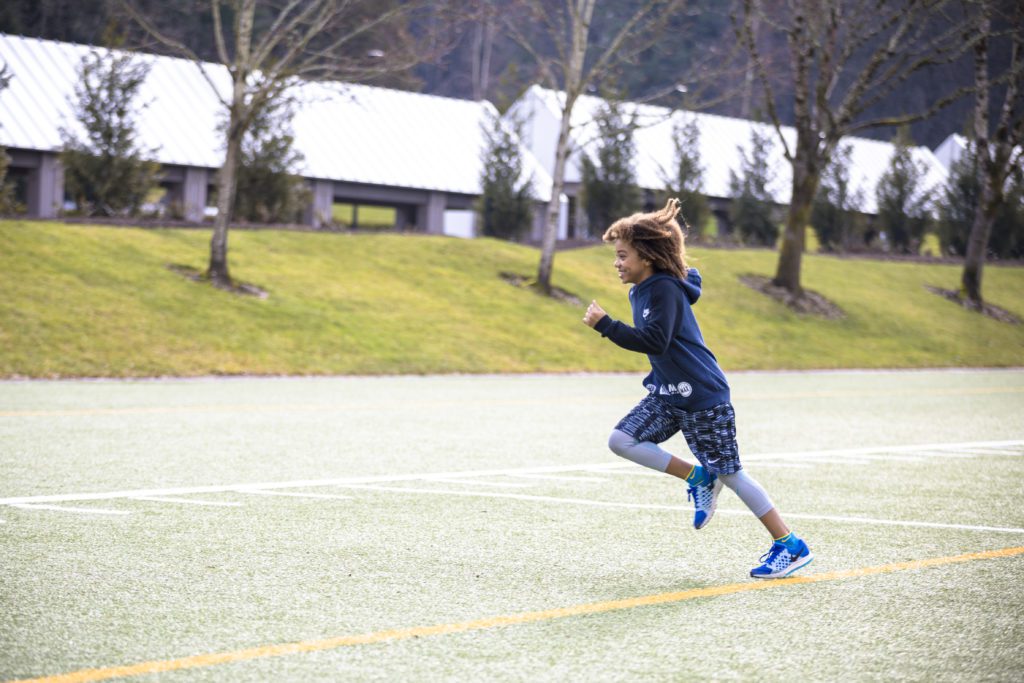
8 Great Outdoor PE Games for Kids
By MK Editor, May 23, 2021
This post is brought to you by CROSSNET, a four-way volleyball net that was designed with the physical education teacher in mind. With just a click of a button and detachment of poles you can easily set up your net to be a variety of heights. This provides gym teachers and volleyball coaches with easy flexibility allowing them to use CROSSNET with both their younger and older students.
There are so many classic outdoor Physical Education games (soccer, kickball, flag football…) that are great for getting kids moving while encouraging teamwork and strategy along with strength and endurance. But that doesn’t mean you have to keep it classic every time the bell rings. Here are eight of the best outdoor PE games, using balls, beanbags, flags, hula hoops or no equipment at all, for keeping things fresh and fun on days when it’s time to head outside and team sports just won’t cut it.
1. Freeze Tag
Great for any age group, freeze tag is just like regular tag, except when a student is tagged, they must freeze with their feet planted widely apart; then they can be unfrozen only when another student crawls through their legs. Teachers can support group cooperation by encouraging students to unfreeze as many of their classmates as possible, and even award points to students who do the unfreezing.
2. Crazy Hoops
While this game works great as an indoor gym activity, it can be even more fun outdoors, where there is plenty of room plus more potential for obstacles and twists. In Crazy Hoops, students build teamwork and strategy skills along with math skills as they work together to grab colored beanbags from a central location and bring them back to drop into their team’s hula hoop. The teacher assigns point values to each color of bean bag: five points for beanbags that match the team’s hula hoop color, ten points for other colors, and one point for white, for example.
If your students are working on fractions or negative numbers, you can incorporate those skills as well (purple beanbags are worth -10 points, for example, or each purple beanbag divides the team’s total points by two).
There are also numerous ways to add twists to this game: You can allow students to use a turn to grab a beanbag from an opponent’s hula hoop and drop it back into the main pile, or instead of locating the main pile in a central spot, divide the beanbags by color and locate the piles in several different areas that students will have to run, climb or crawl to reach.
3. Capture the Flag
This game is great fun when played the traditional way, with two teams, each with its own territory, and one flag per team to guard or steal. Capture the Flag gets even more fun, however, when you switch things up.
Try selecting one spy per team, secretly and at random, who gets one chance to steal the flag belonging to their supposed team and bring it back to their actual team.
Or, for a fast-paced twist, use balls instead of flags and incorporate rules about throwing the “flag” to teammates in order get it back to the home base as quickly as possible. If you have a large PE class, try playing a chaos version of the game by dividing the field or court into multiple sections and having the same number of teams and flags compete for the win.
4. Frisbee Golf
Have students throw soft foam flying discs into buckets, baskets, cardboard boxes and other goals positioned all around your outdoor playing space. This game can be played by taking turns in a big group or in teams, and you can incorporate extra rules, such as having students dance in place for five seconds if they don’t land the frisbee in the goal in three or fewer tries.
5. CROSSNET
This four-square version of volleyball is a super-fun take on the traditional game. Incredibly easy to set up, with adjustable height levels for any age group, it’s a blast for kids from elementary up through high school. CROSSNET targets throwing and catching skills and helps kids develop their hand-eye coordination, while tapping into their competitive natures. It doesn’t take up a lot of room, making it perfect for days when you’re setting up stations outdoors for students to cycle through.
You may also interested in the Best Indoor PE Games for Kids.
6. Hopscotch
This classic game offers great plyometric exercise and balance training along with silly fun. Multiple teams of three or four students each can play at once on multiple hopscotch grids, racking up cumulative team points and competing to win.
It’s easy to switch things up in hopscotch to keep everyone engaged. For example, instead of writing numbers in the squares, have students draw animals, like cats, dogs and frogs, or write down the names of exercises, like jumping-jacks, squats and high-knees, in the squares. When students toss a marker onto a square, they have to make the corresponding animal sound or perform repetitions of the specified exercise before they can begin hopping.
Another twist is partner hopscotch, in which two students hopping along two grids drawn close together must hold hands as they strive to hop with balance and accuracy.

7. Topple Ball
Divide students into teams of four, and set up one cone per team with a tennis or Wiffle ball balanced on top. Have students take turns rolling other balls toward the cones, trying to topple them over. When the ball on top falls, the student who toppled it must try to chase it down and grab it within five seconds to win a point for their team. They also must set up the cone and ball on top for the next teammate to take their turn.
8. Beanbag Relay
Students develop teamwork along with speed and agility in a beanbag relay, which can be held on an outdoor track or blacktop, in an open field, or in nearly any other outdoor space. Set out cones or other markers, divide students into teams, and give each team three beanbags. Teams line up at the starting point with their beanbags, and the first runner from each team runs with one beanbag to drop it at the first marker. Then they race back to grab a second beanbag and run it to the second marker, and finish up by repeating with the third beanbag and marker. When they return to the starting point, they tag the second runner’s hand so the second runner can retrieve all the beanbags in reverse — racing to the first marker, grabbing the beanbag and running it back to the starting line, racing back to the second marker for the second beanbag, and so on.
Bonus: Fartlek Runs
Marathon Kids is all about running, but not necessarily about speed. We believe in getting kids moving by motivating them to cover cumulative distances over time, but we don’t really care about how fast they go — unless they or their coaches want to work on developing their speed. If you have students in track or who are simply interested in improving their running speed and endurance, Fartlek runs are a great way to kick things up a notch.
No, Fartlek training isn’t a PE game, per se — and yes, you’ll have to allow your students extra giggle time to adjust to the silly-sounding name (“fartlek” is a Swedish word that means “speed play”). But soon they’ll recognize the serious fun that Fartlek runs can be. Whereas regular interval training has runners recover between higher-intensity intervals by walking or even stopping altogether, Fartlek training has athletes continue running at a steady pace between bursts of speed, which helps condition both the body and the mind to build speed and endurance. Best of all, the natural challenge and variations inherent in Fartlek training can keep students motivated and engaged.
ABOUT MARATHON KIDS
Marathon Kids is on a mission to get kids moving. The nonprofit organization offers physical education programming and tools through Marathon Kids Connect, a FREE, cloud-based platform that makes tracking and reporting on kids’ physical activity simple.
Make Marathon Kids Your PE Partner
